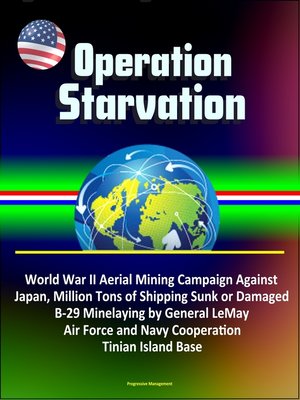Operation Starvation
ebook ∣ World War II Aerial Mining Campaign Against Japan, Million Tons of Shipping Sunk or Damaged, B-29 Minelaying by General LeMay, Air Force and Navy Cooperation, Tinian Island Base
By Progressive Management

Sign up to save your library
With an OverDrive account, you can save your favorite libraries for at-a-glance information about availability. Find out more about OverDrive accounts.
Find this title in Libby, the library reading app by OverDrive.



Search for a digital library with this title
Title found at these libraries:
| Library Name | Distance |
|---|---|
| Loading... |
This excellent report has been professionally converted for accurate flowing-text e-book format reproduction. More than 1,250,000 tons of shipping was sunk or damaged in the last five months of World War II when Twenty-first Bomber Command executed an aerial mining campaign against Japan known as Operation STARVATION. Despite this outstanding success, the decision to commit the still unproven B-29 to minelaying was a close one that rose to the highest levels of the Services. The decision to conduct Operation STARVATION was made not only because mining would lead to a Japanese surrender without the need for a costly invasion of the home islands, but also with an eye towards post-war roles and missions for the Air Force. Once the decision was taken, General Curtis LeMay and his Twenty-first Bomber Command threw themselves wholeheartedly into the mission. On January 23, 1945, LeMay issued a general directive to the 313th Bombardment Wing to prepare for minelaying operations and on March 27, the 313th flew the first of over 50 mining missions. Working together on the remote island of Tinian, Air Force and Navy personnel turned a mission that began as an inter-service rivalry into one of the best examples of inter-service cooperation of the Pacific War. This essay examines the decision making process that led to the use of the B-29 for aerial mining, the planning and execution of Operation Starvation, and the results of the mining campaign.
The decision to conduct a mining campaign as part of the overall strategy to defeat Japan was influenced by the principals' views on the issue of invading the Japanese home islands. The basic policy was to defeat Germany first and to prosecute the war against Japan with resources that could be spared from that effort. By mid-1944, the war against Germany had advanced to the point where Allied leaders could turn their attention to how resources could be best be employed to defeat Japan at the earliest possible time.
In July 1944, President Roosevelt traveled to Hawaii to meet with General Douglas MacArthur and Admiral Chester Nimitz, his senior field commanders in the Pacific. MacArthur and Nimitz were substantially in agreement. In their view, Japan could be defeated by blockade and bombardment, without the need for a costly invasion of the Japanese home islands. No notes were taken, but Roosevelt's Chief of Staff, Admiral Leahy, summed up the conference as follows: "The agreement on fundamental strategy to be employed in defeating Japan and the President's familiarity with the situation acquired at this conference were to be of great value in preventing an unnecessary invasion of Japan which the Joint Chiefs of Staff and the War Department were advocating, regardless of the loss of life that would result from an attack on Japan's ground forces in their own country."
The members of the Joint Chiefs of Staff were divided on the issue of invasion of the Japanese home islands. Chief of Naval Operations, Admiral King, and Army Air Forces Chief of Staff, General Arnold were of the opinion that blockade and bombardment were war-winning strategies on their own. The principal advocate of invasion was the Army Chief of Staff, General Marshal, who saw invasion as inevitable. His considerable influence on the Joint Chiefs of Staff was reflected in the July 1944 statement of the overall objectives of the war against Japan: "first, to force the unconditional surrender of Japan by first lowering Japanese ability and will to resist by establishing sea and air blockades, conducting intensive air bombardment and destroying Japanese air and naval strength; and second, invading and seizing objectives in the industrial heart...







